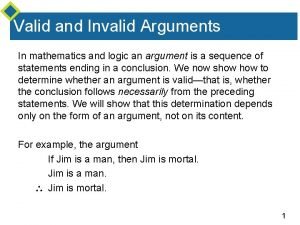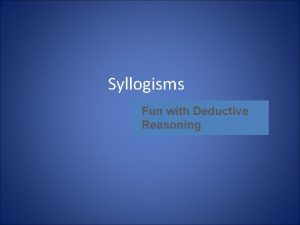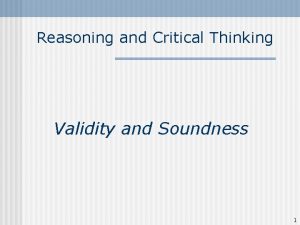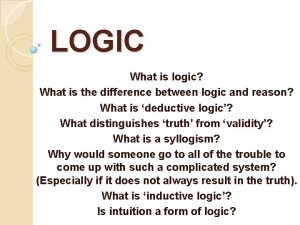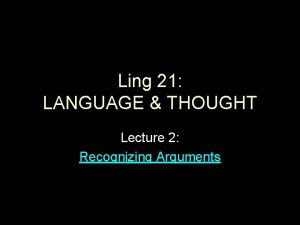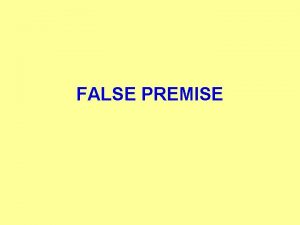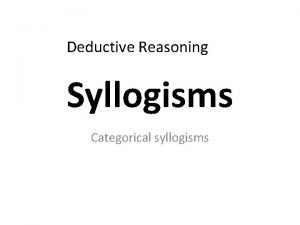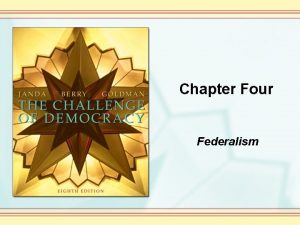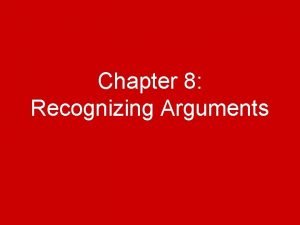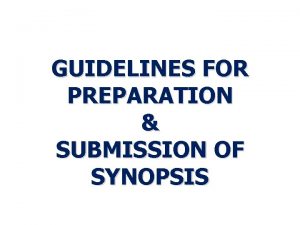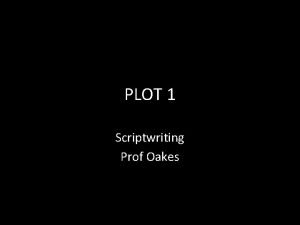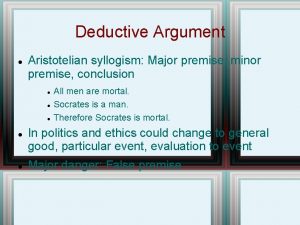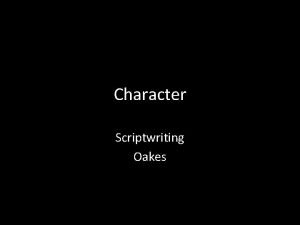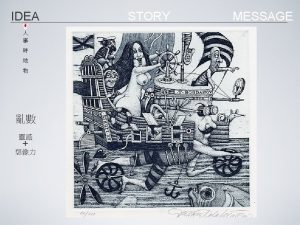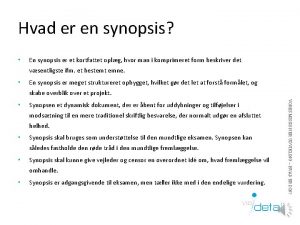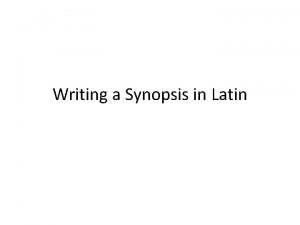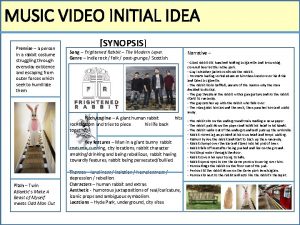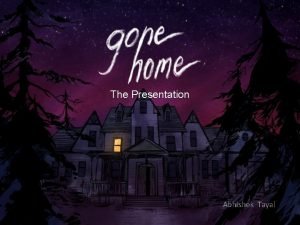Scriptwriting Process Premise Story Idea Synopsis Start Middle




























- Slides: 28

Scriptwriting: Process Premise – Story Idea Synopsis – Start, Middle, End Treatment – Emotional/Sensual Script – See & Hear Only v v v At all stages of scriptwriting continue CHARACTER DEVELOPMENT IDENTIFICATION OF THEME & SYMBOLISM

PREMISE ‘Everything has a purpose, or premise. Every second of our lives has it’s own premise, whether or not we are conscious of it at the time. That premise might be as simple as breathing or as complex as a vital emotional decision, but it is always there. ’ Lajos Egri The Art of Dramatic Writing

PREMISE Ideal stories for storytelling are short and have simple plots. Start, of course, with a protagonist, your main character. The protagonist must encounter a conflict - with another character, society, nature, himself, or some combination of these things - and undergo some kind of change as a result. "Conflict" is also known as the "major dramatic question. " The major dramatic question "is generally a straightforward yes/no question, one that can be answered by the end of the story. What sorts of changes do these conflicts bring about?

PREMISE From there, the character will face various impediments to the achievement of his or her goal. Known as rising action or development, this is part of the story's satisfaction. Audiences like to see struggle, like to feel as though the payoff at the end is deserved. The rising action leads to the climax, the turning point in the story, which in turn leads to the resolution. The central dramatic question is solved one way or another.

PREMISE Form (e. g, a 2 min short film) Genre (Drama, Horror, Thriller etc) Central character Name and age, time period Location Where is your story set? Dramatic Conflict What’s their problem, what would they like to do about it and what’s stopping them? Active Question An unanswered question posed by the dramatic conflict, which engages the reader’s interest

PREMISE The Premise is: A proposition stated or assumed as leading to a conclusion. Lajos Egri The Art of Dramatic Writing A goal. . . The root-idea. . . the Theme. . . How can you tell what road to take unless you know where you are going? Dumas the Younger

Synopsis A Synopsis indicates the main story points and progression in 3 parts: Paragraph 1: Establishment (Characters, Situation, Conflict - Establish) Paragraph 2: Development and Complexity (Develop and Complicate) Paragraph 3: Further Complexity and Resolution (Resolve)

SAMPLE SYNOPSIS (MAX 100 words) RUSSIA, 1900. DR. SERGEI VOLKOV (main character, 35) is wrongly imprisoned for murder. RODCHENKO (35), VOLKOV'S guard, destroys VOLKOV'S only photograph of his daughter. RODCHENKO misses shifts through the loss of his son. When RODCHENKO returns , VOLKOV‘ s sympathy for him seems wasted. With VOLKOV' s last meal , RODCHENKO returns the repaired photograph of VOLKOV'S daughter. As VOLKOV dresses for his execution, RODCHENKO whispers into his ear. Approaching the gallows, VOLKOV'S spirit runs for the door and bursts out into the light as the gallows doors open. VOLKOV'S body dangles and we hear RODCHENKO'S whispered words, asking VOLKOV to look after his son. (98 words)

With the essential story information highlighted: (Paragraph 1: Establishment) RUSSIA, 1900. DR. SERGEI VOLKOV (main character, 35) is wrongly imprisoned for murder. RODCHENKO (35), VOLKOV'S guard, destroys VOLKOV'S only photograph of his daughter. (Paragraph 2: Development and Complication) RODCHENKO misses shifts through the loss of his son. When RODCHENKO returns , VOLKOV‘ s sympathy for him seems wasted. With VOLKOV' s last meal , RODCHENKO returns the repaired photograph of VOLKOV'S daughter. (Paragraph 3: Further Complication and Resolution) As VOLKOV dresses for his execution, RODCHENKO whispers into his ear. Approaching the gallows, VOLKOV'S spirit runs for the door and bursts out into the light as the gallows doors open. VOLKOV'S body dangles and we hear RODCHENKO'S whispered words, asking VOLKOV to look after his son.

Synopsis Don’t be ‘precious’ about your conclusion; tell people the whole story, so that they can give you effective feedback. Share your story and gauge reactions; both your own, and that of others. Don’t bother trying to justify why people don’t get it. . if they don’t get it, make a note and re-work it.

Treatment: A Treatment consists of paragraphs of doublespaced, present tense, moment by moment description. You indicate what the characters talk about, eg. 'he wants her to do this, but she refuses', you never write dialogue in a treatment. Instead you create the subtext, the true thoughts and feelings underneath what is said and done.

Treatment: Why write a treatment, why not start straight into the script? Because otherwise you have to try to write whilst keeping the entire emotional journey of the film in your head, as you write.

Treatment: A treatment should never read like a synopsis, like dull beats of a plot moving forward, trudging toward a predictable outcome. When you’re reading the pages, however simple, the thrill of the story must be captured. And how do you do that? You forget that you’re writing a treatment and tell the story like a classic around-thecampfire cliff-hanger – as if every event happened before your very eyes and you can’t wait to share it.

Example: "Hungry, he heads for the kitchen, but as he crosses the room he notices a note on the dining- room table. It's one of those damn, annoying notes that she's always leaving around, taped to the bathroom mirror or wherever. Irritated, he picks it up and tears it open. Reading it he discovers that she has left him for good. As his legs go weak he drops into a chair, a knot twisting in his gut. His head falls into his hands and he starts to cry. He's surprised by his outburst, pleased that he can still feel some emotion. But his tears are not grief; they're the dam breaking with relief that the relationship is finally over. “ Robert Mc. Kee Story

TERMINATOR A TREATMENT FOR A FEATURE FILM SCREENPLAY by JAMES CAMERON July, 1982 The Present. Los Angeles ghetto. Schoolyard. Night.

Among the spray-painted school buildings a cat prowls between the dumpsters. It looks up, freezing alert, at something beyond human perception. A sourceless wind rises, and with it a keening whine. Papers blow across the pavement. The cat yowls and hides. Windows rattle. The whine intensifies and with it comes a wash of frigid purple light. A concussion like a thunderclap right overhead blows in all the windows facing the yard. The cat's eyes are wide as the glow dies. Electrical discharges arc from the dumpster to a water faucet and climb a drainpipe like a Jacob's Ladder. The sound of stray electrical crackling subsides. In the middle of the previously empty yard stands a NAKED MAN.

Write your Script using your Step-outline as the basis for the structure and your Treatment as the basis for what we See & Hear. A rule of thumb is that a script should run at 1 page per film minute (10 min film = 10 pages excluding title page). Unlike a treatment, a script should contain ONLY what the audience will SEE and HEAR. Do not include descriptions of character’s thoughts and feelings. Instead you should consider the visual and aural signifiers (clues) that will communicate to the audience these thoughts and feelings. Don’t make you script ‘clunky’ by getting the characters to state everything they are feeling, thinking or seeing - find a way to show it (otherwise you might as well be a novelist!) Don’t add camera direction to a script (leave that for the Camera Script). Keep directions for the way things are said (Parenthetical) to a minimum, eg: PAUL (Sternly) Keep it to a minimum. Script

Dialogue should work alongside the image but not echo the image, or state the obvious. Dialogue can paint pictures in the audiences mind, and these pictures are most powerful when they contrast with what is being shown on the screen. Script

Script: Format/Lay-out EXT. VIETNAM - NIGHT A DENSE RAIN falls on a dark night filling puddles of water. JACOB is crawling through the underbrush in the Vietnamese JUNGLE. His shirt is blood-soaked. He moves slowly, creeping on his right forearm. His left arm is holding his intestines from spilling onto the grass. JACOB Help me. Someone.

Script: Format/Lay-out EXT. VIETNAM - NIGHT Setting Action A DENSE RAIN falls on a dark night filling puddles of water. JACOB is crawling through the underbrush in the Vietnamese JUNGLE. His shirt is blood-soaked. He moves slowly, creeping on his right forearm. His left arm is holding his intestines from spilling onto the grass. Character JACOB Help me. Someone. Dialogue

EXT. VIETNAM - NIGHT A DENSE RAIN falls on a dark night filling puddles of water. JACOB is crawling through the underbrush in the Vietnamese JUNGLE. His shirt is bloodsoaked. He moves slowly, creeping on his right forearm. His left arm is holding his intestines from spilling onto the grass. JACOB Help me. Someone. Suddenly a flashlight beam can be seen in the distance. It dances around the bamboo trees and draws closer to JACOB. It is impossible to see who is carrying it. The light darts near the ground where JACOB is lying and then bursts directly into his eyes. Script: Content

INT. JACOB'S APT. - DAY SUNLIGHT pours through the BEDROOM window. JACOB is sleeping fitfully as a bar of light saturates his face. His hand rushes up to cover and protect his eyes but the damage is done. He is awake. JACOB lies in bed for a few moments, dazed. Slowly his hand gropes along the shelf at the head of the bed, searching for his glasses. He has trouble finding them. As his hand sweeps blindly across the headboard it hits the telephone and sends it crashing to the floor. He sits up with a disgusted look on his face and searches the out-of-focus shelf behind him. Suddenly JEZZIE enters. JEZZIE You up? Script: Content

JACOB No. Have you seen my glasses? JEZZIE (shaking her head) Where'd you leave 'em? JACOB I don't know. JEZZIE Did you look around the headboard? JACOB (wearily) Jezzie, I can't see. JEZZIE (she scans the shelf) Maybe you left 'em in the bathroom. Script: Content

She leaves and returns moments later with his glasses and a large paper bag. She tosses them both onto the bed. Script: Content

Your script will change, and change again Script Write 10 times as much as you are going to use, nothing less will do. Do all of the work but only show the audience the best 5% Scriptwriting is writing, and rewriting Once a director is given a script that has been ‘signed-off’ as the Final Version, they will more than likely change it again, as they have to make it work for the screen. . . That’s why it is good if you can write, AND know enough about film production, to direct (Auteur).

Script: Character Development ‘Every object has 3 dimensions: depth, height, width. Human beings have an additional 3 dimensions: Physiology, Sociology , Psychology. Without a knowledge of these 3 dimensions we cannot appraise a human being. ’ ‘It is not enough to know if he is rude, polite, religious, atheistic, moral, degenerate. You must know why. We want to know why a man is as he is, why his character is constantly changing , and why it must change, whether he wishes it or no. ’ Lajos Egri The Art of Dramatic Writing

True character is only revealed through extreme pressure. What is your character’s desire, what do they want? How does this differ from what they need? What is stopping them from getting it? Forget the movies – write about people, about stories. What is your story about, in ONE word? Script: Story Development

What is your story about, in ONE word? Script This is your theme. Explore your theme, it’s associations, and their relevance to your story. Here you will find the symbols that you can use to create pattern, a thematic rhythm, running visually through your story. This pattern of visual symbols provide a subliminal re-enforcement of the message – as in a dream.
 But we gotta start somewhere
But we gotta start somewhere Disaster triage
Disaster triage What time does pinellas park middle school start
What time does pinellas park middle school start Whats the central idea
Whats the central idea Homiletical idea
Homiletical idea Apa itu controlling idea
Apa itu controlling idea Theme and topic difference
Theme and topic difference Example of irrelevant
Example of irrelevant Finding the main idea why were canals built?
Finding the main idea why were canals built? Gwp 1092
Gwp 1092 Voltage secure email
Voltage secure email Unsound argument
Unsound argument Premise control
Premise control Syllogism examples
Syllogism examples Premise control
Premise control Validity in critical thinking
Validity in critical thinking Dynamics 365 on premise to online migration
Dynamics 365 on premise to online migration Saang bahagi ng teksto kadalasang makikita ang paksa nito?
Saang bahagi ng teksto kadalasang makikita ang paksa nito? Only cause fallacy
Only cause fallacy What is logic
What is logic Conclusion indicators
Conclusion indicators Arguments and explanations
Arguments and explanations Siebel on premise
Siebel on premise Ibm cloud backup
Ibm cloud backup False premise in a sentence
False premise in a sentence Major premise in syllogism
Major premise in syllogism What is the basic premise of federalism
What is the basic premise of federalism Conclusion indicators
Conclusion indicators Major premise in syllogism
Major premise in syllogism











